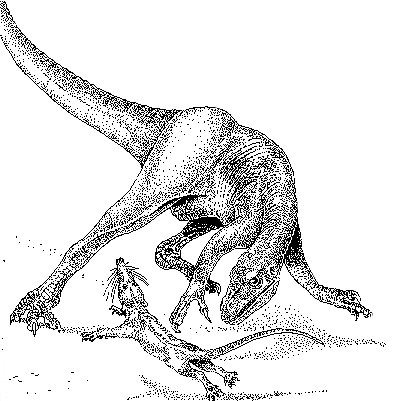 In
1861, the lithographic limestones in Bavarian quarries yielded a fossilized
bird from the Late Jurassic Period, Archaeopteryx
(Background), also called ancient wing.
The Bavarin discovery consisted of a nearly complete skeleton of a dinosaur-like
animal, strongly resembling Ornitholestes
(Right),
with long hind legs and a very long tail.
But there, on the carefully chipped out limestone slabs, impressed into
the fine limey mud were unmistakable imprints of long flight feathers attached
to the forearm and wrist, along with big tail feathers. If there were no
feather imprints, this ancient bird could have and would have easily been
identified as a bipedal reptile (dinosaur).
In
1861, the lithographic limestones in Bavarian quarries yielded a fossilized
bird from the Late Jurassic Period, Archaeopteryx
(Background), also called ancient wing.
The Bavarin discovery consisted of a nearly complete skeleton of a dinosaur-like
animal, strongly resembling Ornitholestes
(Right),
with long hind legs and a very long tail.
But there, on the carefully chipped out limestone slabs, impressed into
the fine limey mud were unmistakable imprints of long flight feathers attached
to the forearm and wrist, along with big tail feathers. If there were no
feather imprints, this ancient bird could have and would have easily been
identified as a bipedal reptile (dinosaur).
It was not until 1872, eleven years
after the ancient bird was pulled out of the quarry that Charles Marsh,
a professor at Yale, originally discovered the bird. He announced that
he had found teeth in the ancient bird. The reason for this late discovery
was due to the poor preservation of the head.